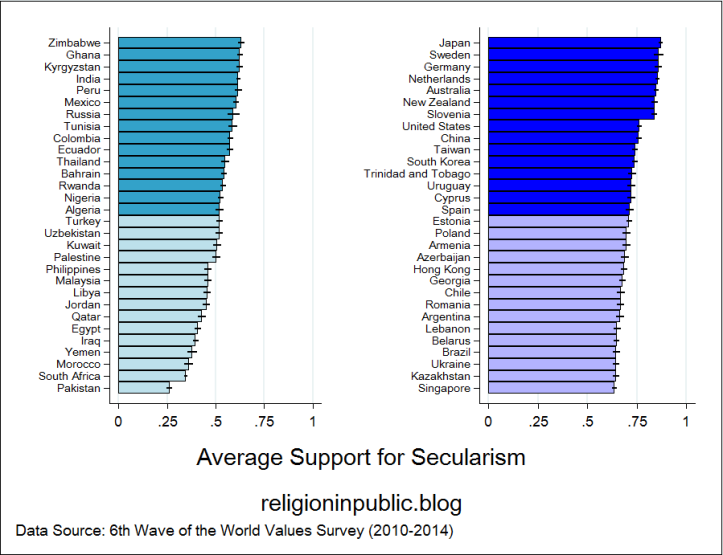By Amy Erica Smith, University of Notre Dame and Iowa State University
A couple of months ago, my much-esteemed (and, thankfully, good-humored) colleague Paul Djupe wrote a great post entitled “Does the Public Want Clergy in Politics?” Given that he focused only on U.S. attitudes, he forgot something important in his title. Here, I fix it for him.

All razzing aside, it’s easy to forget that patterns we see in the United States don’t always hold around the world—even in countries with political systems that are politically similar to our own. This is certainly true of attitudes with respect to secularism, or what in the US we often call the “separation of church and state.”
Do the publics of different countries around the world want clergy in politics? Systematic data on citizens’ attitudes toward clergy in politics are not easy to come by. However, the World Values Survey helps to shed some light on this issue.
In the 6th wave of the World Values Survey, from 2010 to 2014, respondents around the world were asked to report the extent to which they believed that having “religious authorities ultimately interpret the laws” was or was not “an essential characteristic of democracy.” This question ostensibly asks specifically about democracy. However, many scholars have shown that democracy is popular around the world even though people’s perceptions of what “democracy” means varies a good deal (for instance, see here, here, and here). As a result, we can interpret this question as meaning something like “Would it be a good system of government for religious authorities to interpret laws?” This does not tell us about clergy engagement, per se, but it does point to the role of religious authorities in the public square. Arguably, having religious authorities interpret laws—that is, in high roles in the executive and judicial branches—would make a state a “theocracy.”
The figure below presents average support for secularism—that is, opposition to theocracy—in 60 countries. [1] Responses were recoded to run from 0 to 1 so that higher values indicate greater support for secularism and opposition to religious authorities interpreting the laws. Because there are so many countries, I split the figure into two columns to make it easier to read. I also color-coded it by the quartile of the distribution.

In most countries in the world, people on average support separation of church (or mosque or temple) and state. In about three-quarters of the countries where the World Values Survey was conducted, the average score was above the midpoint of 0.5. The U.S. is in the top quartile, but 7 of the 59 other countries have more secular norms than do Americans (52 are ranked lower).
Which states have high support for secularism? Which states have low support for secularism? One obvious hypothesis is that citizens are more likely to support secularism in countries where the legal framework actually establishes separation of church/mosque/temple and state. There are many ways that states and religious institutions interact around the world. Jonathan Fox, for instance, catalogues 111 different kinds of policies that states can adopt that affect religious groups. Even if we look only at countries that are officially secular—that is, ones that are officially neutral toward religion—we find that some states have a legal framework that supports all religions (for instance, Germany), while others try to keep religion out of public life (for instance, France and formerly Turkey and Mexico). (For more on this subject, read Ahmet T. Kuru’s fantastic book.) [2]
Indeed, at the low end of support for secularism are a number of authoritarian regimes and states with official religions. There are also a number of majority Muslim states. However, the patterns are not perfect. South Africa, for instance, has the second lowest level of support for secularism, despite the fact that it is officially a secular country where Christianity is dominant. And Sweden is the country with the second highest level of support for secularism, despite the fact that the Church of Sweden was until recently the official church of state.
Why do some citizens in some places and times want secular states, while others want theocratic ones? Fully explaining the variation found in this figure gives me a new project for future analysis. For the moment, though, it is clear: in most places in the world, the public on average doesn’t want clergy in politics. Except in the places where they do.
Amy Erica Smith is Visiting Fellow at the Kellogg Institute for International Studies, as well as Assistant Professor of Political Science at Iowa State University. Find more information about her here.
____________________________
[1] Because a response of 5 was the modal choice, I re-centered the values, so that a score of 5 received a score of 0.5, even though the midpoint of a 1 to 10 scale is actually 5.5.
[2] Beyond formal policies, the Pew Forum and the Association of Religion Data Archives also show that social tensions within a country can affect a religious group’s actual freedom to practice its religion.

[…] weeks ago, I posted about the huge variation in attitudes toward clergy’s role in politics around the world. What produces this […]
LikeLike
[…] This gives me an opportunity to examine some measures capturing a broader set of roles for religion in politics. The survey, assembled by Ryan Burge and I, was administered to a quota sample consisting of half denominational and half non-denominational Protestants in mid-May 2019 (so expect more posts about non-denominational Protestants in the near future). The results are weighted and we thank the Louisville Institute for the funding. Note: we’ve covered some of this ground about religion’s role in politics before: here, here, and here. […]
LikeLike